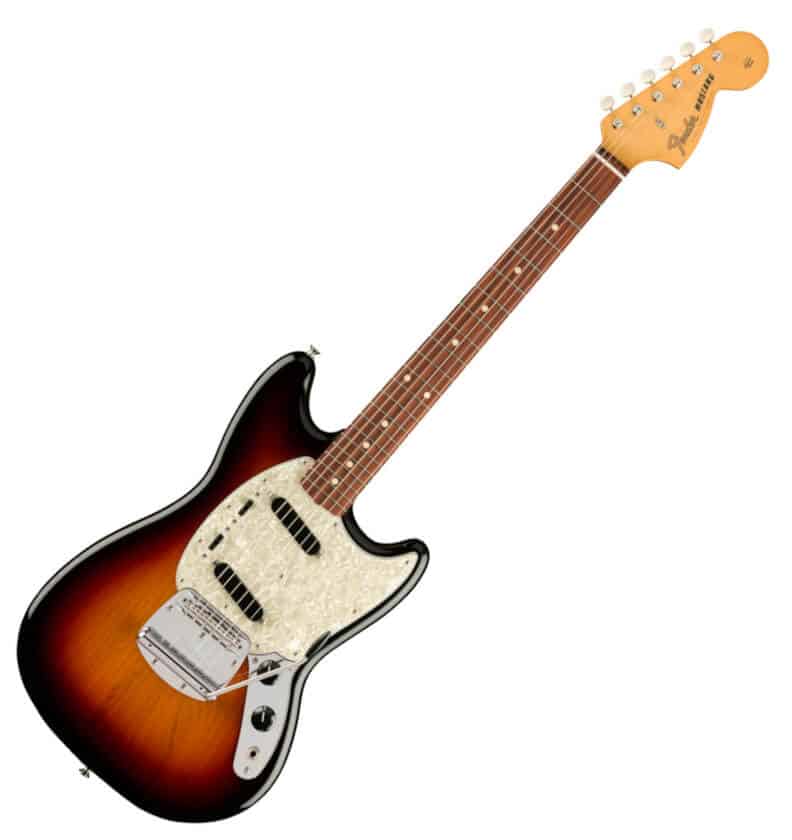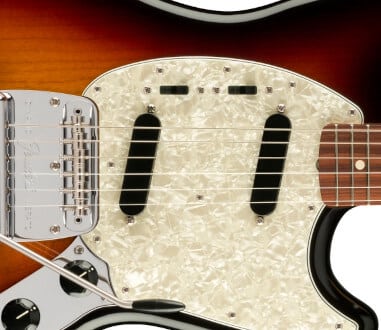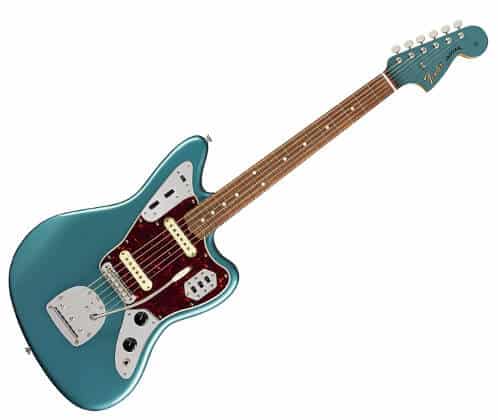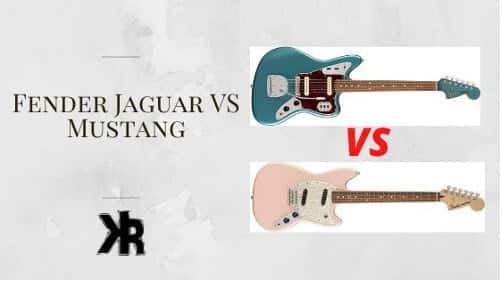Table of Contents
Fender Jaguar and Mustang share the same brand and background. But they are subtly different guitars. Each model gets the job done, they each have features that make them worth considering.
The main differences between the Jaguar and Mustang are the tone, weight, and controls. The Jaguar has a slightly warmer tone. While the Fender Mustang sounds brighter and thinner.
The Mustang is also lighter, and features angled pickups. But the Jaguar has more controls and is more expensive.
Let’s take a closer look at some subtle differences between the Fender Jaguar Vs Mustang. You should know about them before deciding which one is right for you.
Quick Comparison
To sum it up quick so that you have some key takeaways. The differences between the two guitars that are noteworthy are the controls, the weight, and the bridge design.
The weight is based on the fact that the Mustang has a slightly smaller body than the Jaguar.
The bridge on the guitars is different as well. For starters, the tremolo bridge on the Jaguar is further back on the body. The Mustang has a more dynamic tremolo system, however, so this should be considered. The Mustang also has a more modern neck shape.
Otherwise, the similarities are quite obvious. Things like:
- Double cutaway offset bodies
- Maple necks
- Alder tonewood
- 22 frets
- 6″ headstocks
- 24″ scale lengths
- 3-way pickup selectors
As far as sound goes, both guitars are quite similar. But you will find that Jaguar has a warmer tone. As a result, there is less bite in the treble, making it more mellow. The Mustang has more of a unique twangy tone.
Check out our comparison of Fender vs Epiphone guitars here.
Differences Between Fender Jaguar and Mustang
The Jaguar and Mustang have similar backgrounds. Both are distinctly different and have their own pros and cons. Here are the differences between the two models that you should know about.
Sound
When you think about Fender’s Jaguar and Mustang guitars, you can’t help but marvel at their diverse sound spectrums. They’re like painters with an endless palette of colors.
The Jaguar has a soothing, mellow rhythm. But can switch to a growl with just a flick of the wrist. The Jaguar’s unique feature, a rhythm circuit with adjustable bass and treble filters, lets you play with the tone in almost any way you like.
From the light jingle of indie rock to the heavy riffs of grunge. To paint an even better picture for you, think sharp tones with a bite to warm and thick. All by changing the switch arrangement.
On the flip side, the Mustang offers a traditional, robust, and punchy sound. Picture a band at a rock concert. The Mustang’s jangly sound is the one that pierces through the cacophony, a bold statement amid a sea of noise.
But don’t let this strong personality fool you. The Mustang has its soft moments too, making it a reliable companion for musicians from various genres.
So, how do the two compare? The Jaguar is like a spicy dish, packing more heat in the higher tones, while the Mustang provides a well-rounded, hearty tone.
The Jaguar, with its multifunctional control, can mimic a larger variety of tones. The Mustang, on the other hand, gives you a no-nonsense, straight-to-the-point sound.

Body
Both models feature a double-cutaway shape and alder bodies. Although some more popular woods being used for Mustang guitars are poplar and basswood. This will also determine the final weight of each model.
The Fender Mustang’s body is smaller, and so it’s also lighter, weighing only 7 pounds. The Jaguar on the other hand is 8 pounds, which is not a dealbreaker by any means.
Both the guitars feature offset waists, but the Jaguar is more evident. When playing the guitar seated, the offset waist gives it a more balanced feel.
However, having an offset top and bottom means it will take some getting use to.
Pickups
Fender Jaguars, particularly the Player models, come both with single coils and humbuckers. Mustangs have two angled single-coil pickups. For the Vintera 60s models, both Jaguar and Mustang feature two single-coil pickups.
The angled pickups on the Mustang are one of the most noticeable differences between the guitars. When pickups are angled, the higher strings tend to have brighter tones.
While the lower ones tend to sound warmer. This is because angled pickups emphasize the treble and bass. This is based on proximity to the center of the strings.
Neck
Both Jaguar and Mustang guitars have neck wood made of maple. The neck shape of the Jaguar is a modern C. While the Mustang has a vintage C shape.
The main difference is in the size of the carving. It’s known as a modern C because of its slimmer design. Whereas, C-shaped necks are found on most electric guitars.
The Fender Jaguar’s fingerboard is made of pau ferro, while the Mustang is made of maple. For tonewoods, maple sounds brighter than pau ferro, which is warmer.
Maple also has a lighter color, whereas pau ferro is darker and has a reddish hue comparable to rosewood.
Both Jaguar and Mustang have 22 frets with a 24-inch scale length. Jaguars and Mustangs have a shorter scale length than other guitars.
This makes them incredibly easy to play, especially if you have small hands. Both variants are suitable for students because of this feature.
String tension is also reduced thanks to the 24-inch scale length. The shorter scales have a different feel and tone flavor. At least when compared to longer scales, which tend to be brighter.
Don’t forget to check out our Stratocaster vs Jaguar comparison here!
Tremolo
The Fender Jaguar features a floating tremolo tailpiece. While the Mustang has a hard tail with bent steel saddles.
Hard tails, generally known as fixed bridges, are fastened into the guitar’s body. They hold the strings in place on saddles.
Fixed bridges make restringing simple for even the most novice players. They can’t go wrong with passing a string through a hole and up to the tuner.
But, floating bridges allow players to achieve vibrato without bending the strings with their fingers. The floating vibrato mechanism also has a built-in lock.
It helps the musician keep the guitar in tune in the case of a string breaking. While also making the vibrato arm removal easier.
They are less popular and a little more challenging to set up than a regular Stratocaster trem. Thus, the Jaguar and Mustang tremolos and bridges have earned a poor image.
Controls
The Jaguar’s other distinguishing characteristic is its pickup switching system. It features two lead and rhythm circuits with separate controls for each. This allows the guitarist to quickly select between two preset tone and volume levels.
The Mustang, on the other hand, includes a master volume and tone knob. As well as two DP3T switches for each pickup. However, getting used to the switches may take some time as they are situated above the low E string.

Aesthetics and Comfort
Both the Fender Jaguar and the Mustang have similar appearances. They are both very beautiful looking Fender guitars. Their character alone shapes the look of a player.
However, the Mustang has a smaller body, while the Jaguar is about 2 inches wider at the lower bout. This is very noticeable when the two are sitting next to each other.
Some find the Jaguar far more comfortable to play as a result of this. Others think the Mustang is a little more cramped than the Jaguar due to its smaller body.
The Mustang tailpiece is also higher than the bridge. This limits players from resting their palms on the guitar’s body.
Price Range
The Fender Jaguar is more expensive than the Mustang because it has more features. At just $800, the Fender Player Mustang is slightly cheaper. Its Jaguar counterpart costs $880.
The Fender Mustang is also much more affordable, even in models such as the Vintera ’60s. For example, the Fender Vintera ’60s Mustang is only $1,099 compared with a Jaguar, which is $1,379.
Now, these prices are nowhere near enough to exclude one from being a contender, but it’s worth noting. Ultimately, both guitars are affordable and offer great value for their price.
Which is Better: Fender Jaguar vs Mustang?
Are you a beginner? Then the Fender Mustang is better because it has simpler features and is less expensive. However, if you need a more tone palette, then the Jaguar is more suitable for you.
This is because it offers a lot more versatility. You’ll find it easy to get the right tone in Fender Jaguars for any style of music you’re trying to play.
In any case, both guitars can do pretty much anything a player needs them to do. Choosing which is best for you will generally come down to feel and tonal preferences.
Check out our comparison of Fender vs PRS guitars here.
History of Fender Jaguar and Mustang Guitars

Fender launched Jaguar as its top-of-the-line model in 1962. The Jaguar design was highly similar to its predecessor, the Fender Jazzmaster. However, the Jaguar had a thinner, shorter neck and some circuitry upgrades.
Fender came out with a new offset design called Mustang two years later. This was to address the Jaguar issues.
Influenced by both the Jaguar and the Jazzmaster series, the Mustang was also part of a redesign. But this was of Fender’s student guitar line, the Music Master and Duo-Sonic.
Both models had a large following among guitarists at the time. But it was not enough to save the guitar line. As a result, the Fender Jaguar was phased out in 1975, while the Mustang ceased production in 1982.
Fender Jaguar resurfaced in the 1990s. This was after being used by guitarists such as Scott Hill, John Squire, Kurt Cobain, and Johnny Marr.
Fender Mustang also gained cult status around the same time. Alternative rock bands, particularly grunge bands, started using them, including Nirvana.
After their revival, numerous other rock bands began using offset guitar models. So Fender decided to keep manufacturing them. Today, Jaguar and Mustang models are still being produced by Fender. But at various price ranges.
Conclusion
Fender Jaguar vs Mustang, which one of the two is better? There are subtle differences between these two guitars, and there is no right or wrong answer. It will largely depend on what you’re looking for in an electric guitar.
FAQs
What are Fender Jaguars good for?
The Fender Jaguars are a very versatile guitar. They can cover a lot of different music styles. But should you be interested in using one, then you should make sure you like music in the grunge, rock, surf, indie, or stoner type genres.
Can a Fender Jaguar sound like a Mustang?
While a Jaguar also uses single-coil pickups, it tends to be a bit brighter sounding than a Mustang. Now, the Jaguar does have a warm tone to it when set right and can get close, but it’s not going to be exact sonically.

